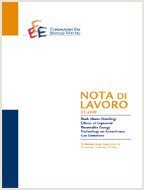Quantifying Catastrophic and Climate Impacted Hazards Based on Local Expert Opinions

11.11.2014
Tim Keighley, Thomas Longden, Supriya Mathew, Stefan Trück
Q5, Q54, Q58
Catastrophic Risks, Climate Impacted Hazards, Expert Opinions, Local Level Decision Making, Loss Distribution Approach
Climate Change and Sustainable Development
Carlo Carraro
The analysis of catastrophic and climate impacted hazards is a challenging but important exercise, as the occurrence of such events is usually associated with high damage and uncertainty. Often, at the local level, there is a lack of information on rare extreme events, such that available data is not sufficient to fit a distribution and derive parameter values for the frequency and severity distributions. This paper discusses local assessments of extreme events and examines the potential of using expert opinions in order to obtain values for the distribution parameters. In particular, we illustrate a simple approach, where a local expert is required to only specify two percentiles of the loss distribution in order to provide an estimate for the severity distribution of climate impacted hazards. In our approach, we focus on so-called heavy-tailed distributions for the severity, such as the Lognormal, Weibull and Burr XII distribution. These distributions are widely used to fit data from catastrophic events and can also represent extreme losses or the so-called tail of the distribution. An illustration of the method is provided utilising an example that quantifies the risk of bushfires in a local area in Northern Sydney.
***
Suggested citation: Keighley, T.,T. Longden, S.Mathew, S. Trück, (2014), ‘Quantifying Catastrophic and Climate Impacted Hazards Based on Local Expert Opinions’, Nota di Lavoro 93.2014, Milan, Italy: Fondazione Eni Enrico Mattei.
This work was supported by funds from the National Climate Change Research Facility (NCCARF) through grant no. EM11 03.
